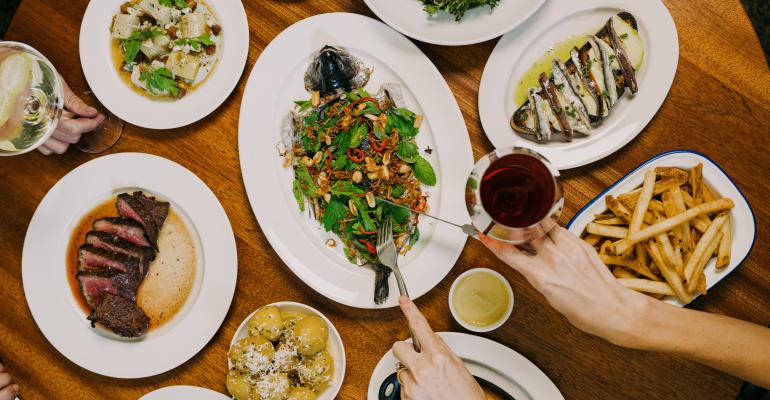Some restauranteurs expand their portfolios by opening new concepts on high-traffic corners or by teaming with hotels. Some look to new neighborhoods to get their food in front of more diners. But others are going all-in on specific areas, opening multiple restaurants in the same communities, and sometimes even on the same street.
While there’s no textbook answer for figuring out where to successfully expand your business, several restaurateurs are focused more than ever on building community and trust within their neighborhoods, especially in a post-pandemic America.
One example is Gus’s Chop House, which opened on Aug. 31 in the Brooklyn neighborhood, Carroll Gardens. The restaurant — which draws inspiration from British chop houses and casual Parisian bistros — is the second concept from co-owners Chris McDade and James O’Brien, who also run the popular American southern-meets-Italian joint, Popina. The two restaurants are an eight-minute walk apart.
“It’s a lot easier to manage two spots when you can walk back and forth,” McDade told Restaurant Hospitality. But more importantly, he and O’Brien wanted to stick with the community that’s supported them over the past five years since Popina opened-- “We’ve built a lot of friendships here. Our regulars are loyal to us, and we’re loyal to them.”
Building relationships with a neighborhood involves more than simply being there, but maintaining a consistent presence helps.
“A great neighborhood restaurant is always there,” O’Brien said. “It’s about showing up for your people. Even during the pandemic, we wanted to nourish the community when no one could dine indoors, so we sold wine, bread and pasta kits.”
At Gus’s and Popina, the owners aim for approachability, both in menu options and price points, serving dishes that people could eat every day. That’s a common thread with other neighborhood-centric restaurants like Omakase Restaurant Group in San Francisco, which operates a slew of popular concepts in the Design District, from the upscale Omakase and Niku, to the more casual Live Sushi and Dumpling Time.
“We are contributing to the overall community by offering several dining options,” Richard Breitkreutz, Omakase Restaurant Group’s vice president of operations said. He adds that having multiple concepts located within a few blocks allows the group to grow its infrastructure and scale up to more locations -- “As an added bonus, our team loves having more than one lunch option in the neighborhood.”
Beyond the physical locations, Breitkreutz notes the importance of forming a connection with the community and providing good quality service and hospitality. “It’s necessary to recognize that it is not about one dinner or one special occasion; it’s about being a part of peoples’ lives. When you do that, you can reliably fill your tables, whether it’s the weekend or a spontaneous Tuesday night dinner.”
Houston’s Goodnight Hospitality has taken over a section of the vibrant Montrose neighborhood, with its concepts, March, Rosie Cannonball, Montrose Cheese & Wine, and the soon-to-open Marigold Club all located on the same block.
“Staying in one area allows for us to continue to concentrate on our team and our community while constantly providing something new,” Goodnight Hospitality CEO and master sommelier June Rodil said. “This provides stability within the restaurants, but it also strengthens the group’s bond with its neighbors and guests.”
Creating that level of goodwill requires genuine interest and effort, whether it’s remembering a guest’s favorite table or keeping an item on the menu because regulars love it.
“We have earned the trust of our neighbors and have a built-in audience now that loves what we do and is always curious what our next venture may be,” Ryan Snyder, Goodnight Hospitality’s director of operations, added.
Creating a hub within the neighborhood helped the group establish an identity and develop a good reputation in a short amount of time — something that might not have happened if the concepts were spread among multiple neighborhoods.
“It’s all about human experiences and growing together. It’s not about being a good neighborhood restaurant, it’s about being a good neighbor,” Rodil said.
Part of that effort includes ownership and management being accessible, available, and present, something that’s difficult to maintain once a restaurant group reaches critical mass.
The guys behind Gus’s and Popina hope to open more concepts down the road, but they’re currently focused on balancing the demands between the established Popina and the just-opened Gus’s.
“When restaurants are new, it’s important that people see your face,” McDade said. “If you grow too quickly, you lose your ability to influence teams.”





